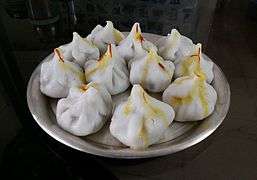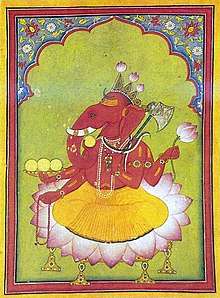Modak
Modak (Marathi: मोदक ) (Japanese: 歓喜団) is an Indian sweet popular in states of Maharashtra, Goa and in the regions of Konkan in India. The sweet filling on the inside of a modak consists of freshly grated coconut and jaggery while the outer soft shell is made from rice flour or wheat flour mixed with khava or maida flour. It is used for Ganesha during prayers.
.jpg) | |
| Type | Dumpling |
|---|---|
| Course | dessert |
| Place of origin | India |
| Region or state | Maharashtra-India, Japan |
| Main ingredients | Rice flour, or wheat and maida flour, coconut, jaggery |
| Variations | Kangidan (歓喜団) |
Modak can be fried or steamed. The steamed version (called ukdiche modak)[1] is often eaten hot with ghee.
Name variations

It is called modak (मोदक) in Marathi, Konkani and in Gujarati languages, modhaka in Kannada, modhakam or kozhakkattai in Tamil and kudumu in Telugu.
Religious significance
Modak is considered to be the favourite sweet of the Hindu deity, Ganesha.[2] It begets him the moniker modakapriya (one who likes modak) in Sanskrit.
During Ganesh Chaturthi, the puja usually concludes with an offering of 21 or 101 modaks to Ganesha as prasadam. Modaks made with rice flour shells are often preferred for this purpose, although wheat shell versions are also used. Local businesses outside Ganesh Temples across India usually sell pre-packed/readymade versions of Modaks.
In Japan, a sweet similar to modak and known locally as Kangidan (歓喜団), is offered to god Kangiten, the Japanese version of Lord Ganesha. Kangidans are made from curds, honey, and red bean paste. They are wrapped in kneaded dough made from parched flour and shaped like a bun before they are deep fried.
Varieties
| Ukadiche Modak | Made of Coconuts and Sugar/Jaggery. This variation is especially prepared during the time of Ganesh Festival. They are hand made and cooked in a steamer. They are perishable and need to be consumed immediately.[3][4][5] |
|---|---|
| Ukadiche Modak | Made of Coconuts and Sugar/Jaggery. This variation is often prepared during the time of Ganesh Chaturthi. They are hand made and cooked in a steamer, perishable, and need to be consumed immediately.[3][4][5] |
| Fried Modak | Deep fried in oil instead of being steamed. Frying makes the modak last longer and have a different taste.[6] |
| Mawa Modak | Generally store-bought. They are completely made from khoa. The other two types can be defined as 'filled' but this is uniformly made from one substance. They come in pistachio, cardamom, chocolate, and almond. |
Gallery
- Modak offered in a Ganesh Puja
- Modak close up
- Inner side with vertical cut
- Inner side with vertical cut
 Modak for offering in Khajrana Ganesh Temple
Modak for offering in Khajrana Ganesh Temple
See also
References
- "Jatra gets its flavour from Maharashtra for authentic taste". The Times of India. Indore. 7 October 2017. Retrieved 19 October 2017.
- Chef Mandaar Sukhtankar (24 August 2017). "A modak by any other name". The Hindu. Retrieved 19 October 2017.
- Khanna, Vikas (2013). SAVOUR MUMBAI: A CULINARY JOURNEY THROUGH INDIA's MELTING POT. New Delhi: Westland Limited.
- Reejhsinghani 1975, p. x .
- Reejhsinghani, Aroona (1975). Delights from Maharashtra. New Delhi. ISBN 9788172245184.
- Modak
